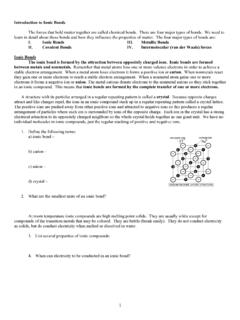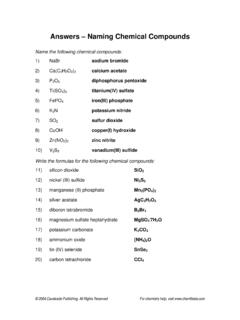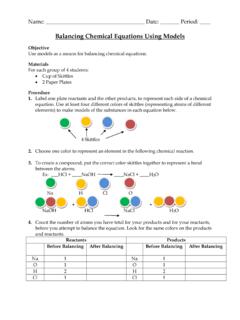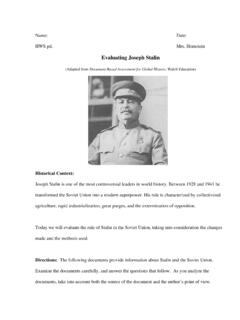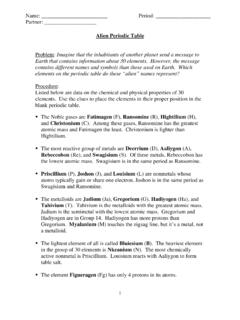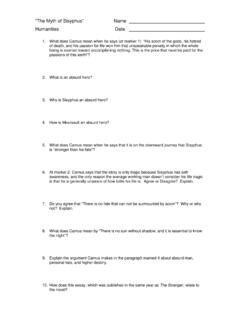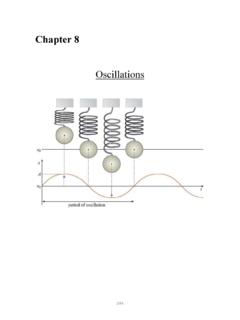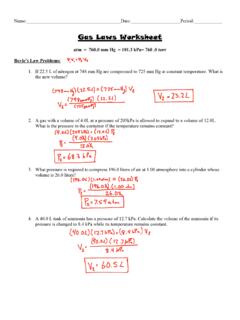Transcription of Chapter 9, Chemical Bonding i: Basic Concepts
1 Chapter 9, Chemical Bonding i: Basic ConceptsLewis Dot Symbols (Sections 9,1 - )Ionic Bonding and the Lattice Energy (Section ) covalent Bonding and Lewis Structures (Sections & )Electronegativity (Section )Formal Charge (Section )The Con_cept of Resonance (Section 9,8)Exceptions to the Octet Rule (Section ) bond Energies (Section )SUMMARYL ewis Dot Symbols ( - 9 2).Lewis ~l. Ionic and covalent bonds are important types of Chemical bonds. Inthis Chapter , you wi!( learn to use electron configurations and the periodic table to predict thetype and the number of bonds an atom of a particular element can form, Electronconfigurations can be used to write the Lewis dot symbols of the representative d,,ot.~mbol of an element consists of the Chemical symbol with one or more dots~ around it. Each dot represents a valence electron. The orbital d~agram and theLewis symbo~-~or the~e atom are shown in Figure 9.!. Fluorine has 7 electrons in its~ outermost principal energy level (n = 2), and therefore has 7 dots in its Lewis symbo{ : F " ~Figure Orbital diagram and Lewis symbol for the fluorine atom.)}
2 " The Lewis dot symbols and the electron configurations of the outermost electrons ofelements in the third period are as foi!ows:~ 3s~3s2 3s23p~ 3s23p2 3s23p3 3s23p ~ 3s23p5 3s23p6 For re r~gz.~senta_tive elements, the number of valence elecirons is the same as the group162 Chemistry, Ch. 9: Chemical Bonding I. Basic Concepts 163 "The representative etals form ions b Iosin all tl-~ vale e, CtLgB~ Lewissymbols can be used to represent the formation of~e magnesium and aluminum ionsas follows: (\oJ ~. ,z-~,j)71~ Ug" ~ Mg~++2e- ~ ~ ~- - ~ ~ ~ ~The ~s form neqative i~ electrons until they are ~a noble gas atom. Ions of nonmetal have 8 electrons in their valence , , 9-2 Sulfide and chloride ions, fo~char,qes of -2 and -1 because theatoms needed 2e- and 1 e-, respectively~, t_o_o become isoelectronic w~ no~6]~s------~~~--_L___~and the Lattice Energy (9 3) "~ ~- . _.~. ~..~ ~u/ornb s La~). The force that gives rise to the ionic bond is the electrical attractionexis ~ng e een a positive ion and a neg,a_tive ion.
3 Chemical Bonding lowers the energy oftwo interacting atoms (or ions). Coulomb s law states that the potential energy (E) ofinteraction of two ions is directly proportional to the product of their charges and inverselYproportional to the distance between them:r=r +r_where Q+ and Q_ are the charges of the two ions, r is their distance of separation, and k is aproportionality constant (its value will not be needed). When one ion is positive and theother negative, E will be negative. Bringing two oppositely charged particles closer togetherlowers their energy. The lower the value of the potential energy, the more stable is the pairof ions. Energy would need to be added to separate the two factors that govern the stability of ion pairs are the magnitude of their charges, andthe distance between the ion centers. The distance between ionic centers (r~ is the sum ofthe ionic radii of the individual energy of attraction between two oppositely charged ions depends:directly on the magnitude of the ion charges.)
4 The greater the ion charges, the strong+erthe attraction. 2 2-..The interaction of Mg and O ~ons ~s much greater than that of Na andCI- on the distance between ion centers. The distance between ions depends on~the sizes of the ions involved. As the sum of the ionic radii increases the interactionenergy Chemistry, Ch. 9: Chemical Bonding I: Basic , 1 mole of gaseous K ,ions, and 1 mole of gaseous Cl- ions are combined tomake 1 mole of KCI(s), An amount of energy equal to the lattice energy will be lattice energy must have the same magnitude as A~, but an opposite sign,K+(g) +CF(g)-~KCI(s)oAH~ = - lattice energyThe summation of the steps gives the overall reaction , in general:AH~ (KCI) = AH~.~ + BE + I(metal element) - EA(nonmetaf) - lattice energyor&Howr~tl AH~ + AH2 + &H~ + AH: + ~H5where AH5 =-lattice energy H; -lattice energy = AHs = AH~,~,~I- [ A + AH~ + AH~ + AHCovalent Bonding and Lewis Structures ( & )_-:----- ~i9,3, ~9-3 - 9-Octet Rule.]
5 In our study of the periodic table we saw that the valence electronconfiguration was related to the Chemical and physical properties of an element. The noblegas elements are the least reactive, and therefore the most stable group of elements. TheLewis dot symbols of the noble gas elements show eight valence electrons corresponding tofilled s and p subshells. G. N. Lewis reasoned that when atoms enter into chemicalcombination they become more stable. He proposed that atoms gain or lose electrons untilthey have the same number of valence electrons as noble gas atoms, that is, eight. Theoctet rule states that when forming bonds atoms of the representative elements tend to gain,lose, or, share electrons until they have eight electrons in the valence are held together by bonds resulting from the sharing of electrons betweentwo atoms in a manner that is consistent with the octet rule. A s!mple covalent bond isformed when two atoms in a molecule share a pair of formation of a covalent bond in hydrogen chloride can be represented with LewisH + ".
6 ~. 1:--> H ;~. ~1: or ~where th~sents a covalent bond .,, or a_~oair of electrons shared by both and the~. By sharing the electron pair, the_CI atom has ei_g.~.valence ~s, The stability of this bend results from both atoms acquiring noble gasconfigurations. Notice that ~en is an exception to the octet rule. Rather thanachieving an octet, ] ~LL~Zw~g~C~s to achi~~ The Hatom bece i ele ic with helium. The-~ pa~-n-~ CI atom that are not "~involved in Bonding are called lone pairs, unshared pairs, or nonbonding electrons. Thesharing of valence electrons in methane and carbon tetrachloride is shown in Figure 9, circles represent the valence shells of the atoms. They help to point out that each atomachieves an octet of valence electrons by sharing one or more pairs of , Ch. 9: Chemical Bonding I." Basic Concepts 167 Figure ~ electron pairs in CH4 and CCI4,In some cases two or three airs of electron~ two atoms~rder to reachan these molecules,~~.
7 A doubie bond is~w~ch two ,oairs of electrons are shared between two atoms, as between C and O informaldehyde."2CO (formaldehyde)H~ or --C= 6 / ~ <~ ~_-~l~ atoms bined b a double bond lie closer t~ than atbined bbond. The ~s shoK~r than the C--O bond length.~~ ~en molecules (N2) contain a triple ~is Structures. kewis structures re~resent the covalent bondin~ an6 locationunshare6 electron ~a~rs within molecules an6 ~o~gatomic ~ons. The ste~s fo~ wdfln~ kewisstructures are as follows ~ ~ ~__ ~ . ,~)ArranRe the atoms in a reasonable skeletal form, placing the unique atom in the cent~~ine what atoms are bond ~.~~the valence electro~.( F~atomic anions remember to add one electron foreach unit of ch~~~ct the central atom to the surrounding atom~ with sinqle bonds. First, add~shared pairs t# th~onded to th~central atom to complete the(exceptfor hydrogen, of course). Then, keeping in mi6~that the maximum number of electronsis the number counted in step 2, add tSe remaininq unshared#airs to the central atom.
8 ~ I~the octet rule is satisfied for each atom, ~ the total number of electrons is~ here since t~e structure can be considered correct. If the octetrule is not met for the central atom o on to te 5. ~ Examples~~cases, there is a sho~age of valence electrons. T~lete the ~the central atom we must write dou~ bonds between the c~atom and the surroundinq atoms. To make a double b~d move one ofth~Exercises~hared pairs from the surrounding atom to make the additional - 9-86., Repeat steps 4 and Example 9:5 for application o~ procedure. ~Chemistry, Ch. 9: Chemical Bonding h Basic Concepts 169 Here 5 denotes a partial charge, that is, a charge less than , as it would be in an covalent Bonding , which is the equal sharing of electron pairs, occurs inhomonuclear diatomic molecules. Examples are H2, N2, and CI2. In a diatomic molecule withboth atoms the same, Az must be zero, and the Bonding electron pair is shared of this type are described as nonpolar covalent bonds, or pure covalent bonds involving different atoms, the electronegativity difference will depend on therelative electronegativities of the two atoms.
9 When Az > a bond is mostly ionic, for in thiscase one atom exerts so much more influence on electrons that they can be considered tobe completely transferred to the more electronegative atom. Bonds between atoms suchthat Az < are classified as polar covalent bonds, or simply polar bonds. The " rule"isan approximation and does not apply to all ionic ,polar covalent bonds and completely ionic bonds represent extreme situations inbonding. To refer to a bond as being "ionic" or " covalent " is an the term percent ionic character is used to describe the polar nature of a purely covalent bond has zero percent ionic character. Bonds that have&z > have at least 50% ionic character and are called ionic. There are no 100% ionicbonds. Compounds of Group 1A or 2A metals with a nonmetal usually have ionic bonds,whereas compo,,nds of two nonmetals usually have polar covalent bonds. See Table 9,3 bond Character of Some Common Bondslenic Compounds , covalent BondsC--CIN--HO--HS--HS--ON--OFormal Charge ( ) - 9-13F~ on Lewis Structures.
10 The conce tof forma! char~,e rovides ar~_r~l~~ture from a reveral~s. The formal charge is the charge that an atom seems to h~ Je in a Lewisstr~cture. When determining the formal charge al! nonbonding electrons count as belongingentirely to the 3tom in which they are found. All Bonding electrons are divided equallybetween the bonded atoms. Thus, the formal charge of an atom in a Lewis structure is th170 Chemistry, Ch. 9: Chemical Bonding h Basic Conceptsnu er of va ence electrons in an isolated atom.[~n nus the num~ctrons assigned tot~_hat atom in a molecule. The form_ .ula for the form_al charge of an atom ~s.~ forma ------~-~-(numbe~ ofcharge=[.valence) -nonbonding electrons 2 Bonding electrons)It will be good to keep in mind that the formal chaige is really more a property of a structuralformula than that of the species the formula represents. Formal charges do not indicate~ on atoms in the real possible Lewis structures for BF3 are:F: :F:""(1)(2)~The formal chargesin (1) are:-~,~,,~ _~ ~6~.]]
